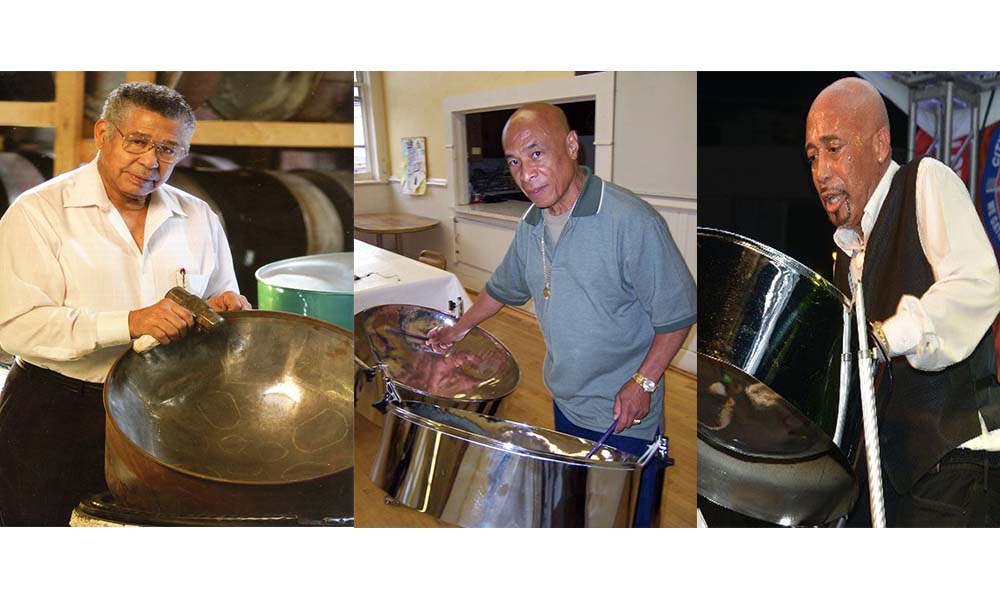It’s a fact of life that people are born, live their lives and die. Some live quietly by getting “normal” day jobs, raise families (or not) and generally enjoy whatever meaningful moments come their way. Some choose to strive for more, to sacrifice and risk everything for their dreams and chase them down, no matter the cost. August and September 2018 were particularly hard on the global steelpan community as it saw three of its biggest contributors pass away who fall into the latter category: Dr. Ellie Mannette, Ken “Professor Philmore and Kim Loy Wong. Each man made his mark through dedication that most of us will never match or comprehend. It’s astounding once you know the level of work and effort it takes to achieve on the level that each of these pan men achieved.
Dr. Ellie Mannette
When one thinks of the progression and advancement of the steelpan instrument, it’s hard not to think of Ellie Mannette. There at the instrument’s inception, Mannette became one of the most innovative steelpan builders and tuners, credited by many with being the first to use a 55-gallon oil barrel instead of biscuit tins or soap boxes. He was also known as the first to sink the top of the drum into a concave shape to allow more space for notes and allowing for better isolation between the different pitches. Instruments he is credited with inventing include the Invader style tenor pan, double seconds, quadduet, cellos, triple guitars, tenor bass and six bass. Considered “the father of the modern steelpan instrument,” Mannette traveled the world promoting the instrument and sharing his knowledge with many people who would go on to spread his legacy through performance, pan building and education around the globe.
Over the years, Mannette led and performed with many bands including TASPO (Trinidad All Steel Percussion Orchestra) and Invaders, of which he founded. After traveling to the U.S. to build instruments and help launch the U.S. Navy Steel Band, he was invited to New York City by social worker, Murray Narell, father of Jeff and Andy Narell, to build instruments for an inner city youth program. He carried this format of building and teaching the instrument to countless programs across the country, helping to spread the instrument in the U.S. largely through his workshops with apprentices like Chanler Bailey, Emily Lemmerman and Alan Coyle, among many others.
One such apprentice, Ryan Roberts, has been studying with Mannette at his workshop in Morgantown, West Virginia for the last five years in the hopes of gaining as much knowledge as possible from the pan master.
“I first met Ellie in 2008 through a road trip with Mosaic Steel Orchestra. The band was invited as a guest appearance for a steel pan concert held at James Madison University in Harrisonburg, Va,” Roberts said. “The first moment I met him was when he gave a small lecture about his life as well as performed on his personal triple guitars. My first impression of him was how amazing of a person he was as well as what he did for the steelpan. Also, his guitars were so beautiful with their tone and balance. I had never heard a steelpan sounding so pure in my life at that time.”
After meeting Ellie in 2008, Roberts started developing an interest in tuning steelpan. “I started to become obsessed with it, even buying some ball pein hammers and trying to teach myself how to tune with my first tenor pan (not recommended at all by the way, lol),” Roberts said. In mid-2013, after years of trying to get his foot in the door at Mannette Instruments, Roberts was allowed to apprentice with Mannette.
“When I arrived, Ellie was ready to retire, but when he noticed how much drive and ambition I had for pan, he told me it reminded him of himself as a young man. He took me under his wing and started showing me the tricks of the trade,” Roberts said. “One of the biggest lessons Ellie taught me about pan was that not one pan will tune the same as the last. You can build two tenor pans out of one barrel, follow the exact same steps, and yet they both will tune slightly different as well as have a different tone. He would show me that each note must be thought of as an individual puzzle. Meaning, find every issue that’s causing the note not to ‘spark’ or ‘sing’ as it should. He also taught me to never rush to get an instrument done. The more time you spend, the better the final product will be.”
A life lesson Ellie taught me that I will always use is never to settle for less. As most know, Ellie was a perfectionist, especially when it came to developing the steelpan. He would always be trying to push the limits more and more up to the very end of his life,” Roberts added. “I started to treat my vision of pan the same way. Each pan I craft, I always try to make it better than the last, take notes, compare and think what can I do to make this instrument even better. By doing that, I feel as if the instrument will continue to develop and get better over time. That was Ellie’s biggest lesson he taught all of his students. Never settle for less and ‘go for broke,’ as he always said.”
Ken “Professor” Philmore
From the age of seven, Ken Philmore played and loved the steelpan. He was mesmerized by every aspect of what he saw the first time he heard pan at a J’ouvert competition. Even having just passed away at the age of 59, “Professor”, as he was known to fans, friends and family, had the same love he started with for the instrument.
Believing his interested and skill in pan was some sort of divine intervention, Philmore worked hard to develop his talent by practicing as much as eight hours per day. Eventually, his hard work would pay off and land him the arranging duties for Fonclaire Steel Orchestra.
Known for his fast-paced, intense style, Philmore won the hearts of many with his contribution to the Lord Kitchener classic “Pan in A Minor,” lending his talents to the track as a soloist. In 1990, Philmore composed and arranged perhaps his most famous piece, “Pan by Storm,” which won he and the band second place in that year’s Trinidad National Panorama competition. The piece was also his favorite to have ever composed and arranged.
Being from San Fernando, Philmore had two primary goals he fought for in his time as a thought-leader in pan: get steelpan in the curriculum in every school in Trinidad and Tobago and bring a win or at least more respect and notoriety to the Southern region of Trinidad where he was from, being a native of San Fernando. While he was happy with the progress the instrument has made abroad, he felt that there was more work to be done in his home country.
“My opinion of that is two-fold. I believe our children are deprived of the joy of playing and learning this wonderful instrument as it’s not a part of the curriculum and Trinidad and Tobago is the mecca of pan. On the other hand, thanks to the pioneers who took our great artform worldwide, today over 70 countries are playing pan. So, it’s rapidly growing abroad,” Philmore said in a 2016 interview with PAN Magazine. “We are on the right course. The standardization of the instrument is coming along slowly but surely. The sound of the instrument has improved tremendously over time. Lots of countries are embracing it.”
The impact Philmore has had in his time had a tremendous impact on people all over the world. One such person was composer Mark Loquan, known for having many of his songs arranged into Panorama charts, including several by Philmore.
“Trinidad and Tobago has lost one of its greatest pan ambassadors, one who would live in our hearts forever. The outpouring from all around the globe tells you how much Ken has touched so many people,” Loquan said of Philmore at his funeral. “My last words to Ken in ICU (Intensive Care Unit) was ‘Thank you for the music, the world will miss you dearly. May you rest in peace, my brother.’ Now take the heavens by storm.”
Kim Loy Wong
One of the pioneers of the steelpan movement from its earliest days in the 1940s, Wong was a member of the first teenage steelband in Trinidad, known as the East Side Kids. He worked with other bands until starting the HiLanders in the 1950s.
In 1956, Wong was approached by U.S. folk singer, Peter Seeger, who was interested in the steelpan instrument. Seeger filmed a 15-minute documentary called “Music From Oil Drums” which featured Wong. The film won the “Chris award for excellence in Production, Information and Education in 1958. An instruction manual was produced in conjunction with the film called, “The Steel Drums of Kim Loy Wong,” co-authored by Wong and Seeger, and may have been the first-ever book to document how to make and play the steelpan.
Wong moved to New York in 1959 to become one of the few panmen to introduce steelband music to the United States. Upon arriving, Wong started several steel drum programs for troubled, inner-city youth, including the Henry Street Settlement; Educational Alliance on South Broadway; Leak & Watts in Yonkers; Dr. White Centre in Brooklyn; Graham School in Yonkers; and Children’s Village.
During his time in New York, Wong performed with many famous performers, including Richard Prior, Richi Havens and pianist Liberace (which included performances at Madison Square Garden and Carnegie Hall.) He opened for popular acts that included Ike and Tina Turner, Dionne Warwick, Stan Kenton, The Rolling Stones and John Lennon. He also performed for four first ladies: Eleanor Roosevelt, Jackie Kennedy, Lady Bird Johnson and Rosalyn Carter. In 1980, Wong moved to Houston, Texas and started another steelband, PanMasters.
Renowned steelpan composer and performer, Andy Narell, reflected on his former teacher in a social media post shortly after Wong’s passing. “He was a truly great panman of another era when tuners were the leaders of their bands, and they arranged and played as well. He gave up his leadership of the Highlanders Steel Band to emigrate to the USA, and in the early sixties when we started playing, he was the man in New York. He was the best tuner in America, and had a working steel band – featuring himself on tenor pan – that recorded and appeared on TV,” Narell said. “He wrote a book on building and tuning pans, and taught steel bands in community centers. He showed me how to hit a grace note and use it for emphasis, a one minute lesson that has served me well. We can thank Pete Seeger for bringing Kim to the U.S. – the first person to take that step. He’d met Kim in Trinidad and made a beautiful film about pan, featuring Kim and the Highlanders. My favorite moment is when Pete tells him he’s so glad to be bringing pans home with him and promises to do right by Trinidad. Kim responds – ‘Instead of taking up the pans, take me up instead. Put me in the box instead of the pans.’ That’s how bad he wanted to go. He was ready to stow away.”









